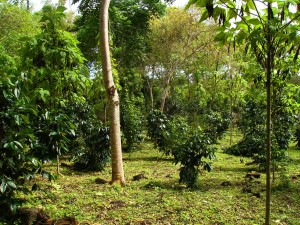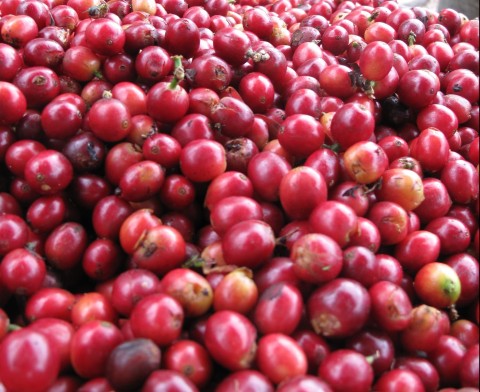World famous as a crucible of evolution and for their remarkable flora and fauna, the Galapagos Islands are both fascinating and fragile. But amidst the giant tortoises, diving iguanas and blue-footed boobies, a handful of farmers are also trying to put these islands on the map as a source of exceptional coffee.
Growing coffee, an imported plant of African origin, in Galapagos’ delicate native ecology may at first seem to be intrinsically at odds with conservation. But on the some 3% of the Galapagos’ territory that is not strictly protected as a national park, local communities live, work – and farm. And coffee farming, when done right, provides a unique opportunity to integrate and enhance native flora and fauna into the landscapes and livelihoods of these settled areas.
 The moist highlands of many of the Galapagos Islands used to be blanketed with dense forests of native Scalesia trees – a gigantic member of the daisy family, represented by different species on different islands, much like the famous Darwin’s finches. Unfortunately the soils and climate that were good for Scalesia, and all the other endemic oddities that comprised this forest ecosystem, were also those best suited for agriculture in the eyes of the settlers who began establishing farms there decades ago. Now, these unique Scalesia forests have been virtually eliminated from Santa Cruz and other islands, replaced by farms and, to a very large extent, dense, choking thickets of invasive, non-native blackberry bushes and guava trees. Controlling these invasive species is a costly and never-ending battle, fought with machetes, poisoned axes, herbicide and brute, repeated effort.
The moist highlands of many of the Galapagos Islands used to be blanketed with dense forests of native Scalesia trees – a gigantic member of the daisy family, represented by different species on different islands, much like the famous Darwin’s finches. Unfortunately the soils and climate that were good for Scalesia, and all the other endemic oddities that comprised this forest ecosystem, were also those best suited for agriculture in the eyes of the settlers who began establishing farms there decades ago. Now, these unique Scalesia forests have been virtually eliminated from Santa Cruz and other islands, replaced by farms and, to a very large extent, dense, choking thickets of invasive, non-native blackberry bushes and guava trees. Controlling these invasive species is a costly and never-ending battle, fought with machetes, poisoned axes, herbicide and brute, repeated effort.
Shade-grown coffee, pioneered by farmers like Scott Henderson of Lava Java, opens up a different pathway. Lava Java runs the first organic and bird-friendly (http://nationalzoo.si.edu/scbi/migratorybirds/coffee/) certified farm on the island of Santa Cruz. By using Scalesia and other native and endemic tree species to provide shade within the coffee plantation and avoiding the use of herbicides, conservationist farmers like Henderson are able to restore endangered species and create a microhabitat where native fauna also find refuge. The returns from the coffee make it easier to control aggressive invasive species and restore a hybrid ecosystem rich in native species. Henderson describes the planting of endangered Scalesia as “the plant equivalent of captive breeding of giant tortoises.” Organizations like Conservation International have been supporting Scalesia coffee on Santa Cruz Island, drawn by the positive bottom line benefits for biodiversity and for farmers.
 Native species also bring their unique challenges, requiring unique solutions: few coffee growers elsewhere have to deal with pest problems in the form of passing giant Galapagos tortoises bulldozing their crops. Coffee finds ideal growing conditions in the highlands of the Islands, with yearlong rainfall and good soils. Tortoises are fond of these conditions too – a green cool oasis upland from the parched, thorny coasts that ring the islands – and migrate each year to quench their thirst and feed on green pastures.
Native species also bring their unique challenges, requiring unique solutions: few coffee growers elsewhere have to deal with pest problems in the form of passing giant Galapagos tortoises bulldozing their crops. Coffee finds ideal growing conditions in the highlands of the Islands, with yearlong rainfall and good soils. Tortoises are fond of these conditions too – a green cool oasis upland from the parched, thorny coasts that ring the islands – and migrate each year to quench their thirst and feed on green pastures.
If your farm happen to be in the way of these slow gentle giants, then your coffee plants, especially young ones, may be at risk. Adult tortoises can easily top 150 kilos (330lb) and while they don’t feed on coffee itself they will casually plow over insignificant obstacles like these – and through barbed wire fences – on their way to their destinations. Jadira Larrea, a coffee grower on Santa Cruz Island, lost many 3-year-old plants when tortoises overnight carved out a water pond near her crop. “How should I beat the turtle?” Larrea asks, “Does one really want to take away the water supply created by the slow effort of an endangered species?” In the end, Larrea accepted the loss and the newly established tortoise territory as one of the conditions of farming in Galapagos. Coffee moved a bit to the side, additional and more convenient ponds were dug further from the plantations, and tortoises and farming managed to live side by side.
Several growers are now producing Galapagos coffee and the small-scale production is acquiring a following in Ecuador and abroad, with the Ministry of Agriculture working on establishing a Denomination of Origin.
So how good is the coffee? A trip to the Galapagos is the best way to find out. But if that may have to wait, you can find and contact Lava Java on Canopy Bridge.



Hi,
We are a China based whole sale coffee company. We will be visiting Ecuador this coming August and are interested in visiting coffee producers in the Galapagos. Grateful if you would give us information on how to contact coffee producers in the area. The purpose of our visit is to assess the different types of coffee and to make arrangements for export to China.
Many thanks,
Felipe